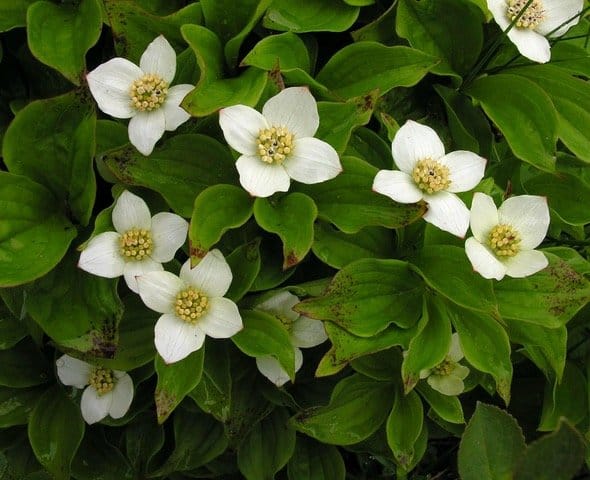
Now here’s a line you don’t hear every day: “Bunchberry has been in the news this week!” Yes it’s true, and although you may not recognize the name, you’ve likely seen bunchberries if you’ve ever hiked through a Canadian forest in late spring (small, upward-facing white flowers) or in autumn (red berries atop burgundy leaves). It’s a truly lovely forest groundcover.
The Canada 150 celebrations have sparked many new initiatives, and it occurred to one Canadian gardener that although we have 13 outstanding provincial and territorial flowers, Canada itself doesn’t have a national floral emblem. So an online poll was organized, and votes were cast to select Canada’s national flower. Last week, 10,000 participants declared the bunchberry (Cornus canadensis, Zone 2) the winner. I was puzzled by this choice of a relatively unknown dogwood sub-shrub, and wondered why the competition had been restricted to the small handful of plants that are native to every province and territory.
The United States didn’t have a national flower until 1986 when Ronald Reagan named “the rose” as America’s national emblem, but what rose, and where does it grow? Some countries — like Canada and Ireland — have familiar botanical emblems (the maple leaf and the shamrock), but don’t have official flowers per se. Other countries have more than one horticultural emblem: Portugal has five: (cork oak, hydrangea, lavender, olive and red carnation) followed by Macedonia with three (opium poppy, tobacco and wheat).
So for many much smaller countries, floral emblems apparently need not necessarily be widespread or even native. But in a country as large and climatically diverse as Canada, this restriction of “must grow everywhere” seems particularly limiting. And while bunchberries may have a presence in every province and territory, they don’t flourish in the heat of Zones 6 to 8, putting them firmly out of reach for some of Canada’s keenest gardeners.
Bunchberries are essentially a plant of our coniferous forest floors, and demand an acidic soil if they are to thrive (in the wild, a soil pH level of 4.0 is not unusual). And unless they’re situated in a blueberry bog — where they’re considered a weed by berry growers — they’re happiest in the year-round shade cast by evergreens. In perfect conditions, individual plants may grow more than 15 feet (4.5 m) wide, spreading slowly via their creeping underground rhizomes.
But in the average home garden, bunchberries can be the very devil to grow. As Paul Cappiello and Don Shadow write in their encyclopaedic Dogwoods (2005), “Culture of bunchberry is one of those enigmas in the gardening world. Surely with [its] diversity, the plant should be adaptable to a wide range of garden conditions. Alas, once again, Mother Nature has thrown us a knuckleball. As it turns out, outside its natural range, the plant is an absolute beast to grow.” And so it is — which is why it’s almost impossible to find bunchberry at most nurseries.
And production presents another problem: Plants grown from seed (or cuttings) collected in one region of the country are unlikely to thrive in another region. Local populations are adapted to seasonal precipitation and temperature patterns as well as soil types and exposure.
Cornus canadensis is one of many plants that bear the specific epithet (species name) that means “of Canada.” Other plants (such as Aquilegia canadensis and Asarum canadense) were also given the same specific epithet by botanically minded Jesuit missionaries in Quebec in the early 17th century. But this is by no means any guarantee of exclusivity, and when Linnaeus (1707-78) officially named the plant a century later, he described its natural distribution as “circumboreal,” meaning that bunchberry is indigenous to boreal forests (or Taiga) across the northern hemisphere.
And therein lies the crux of the matter: In addition to being indigenous to every Canadian province and territory, Cornus canadensis is also native to the U.S. as far south as the Carolinas (at high altitudes) — as well as to Russia, China, the Koreas, Japan and Greenland.
I would have preferred the nomination of a species that’s native to most of Canada, which would have widened the list of candidates considerably. And I’d have chosen one that’s available at nurseries and that isn’t “an absolute beast” to grow in a typical Canadian garden.
As for the bunchberry becoming Canada’s official flower, it still has several Department of Canadian Heritage hoops to jump through before it’s green-lighted, and given the Canada grey jay’s wobbly flight path toward federal recognition, there’s probably still time to go back to the floral emblem drawing board.
Share your thoughts
What flower would you nominate as Canada’s national floral emblem?


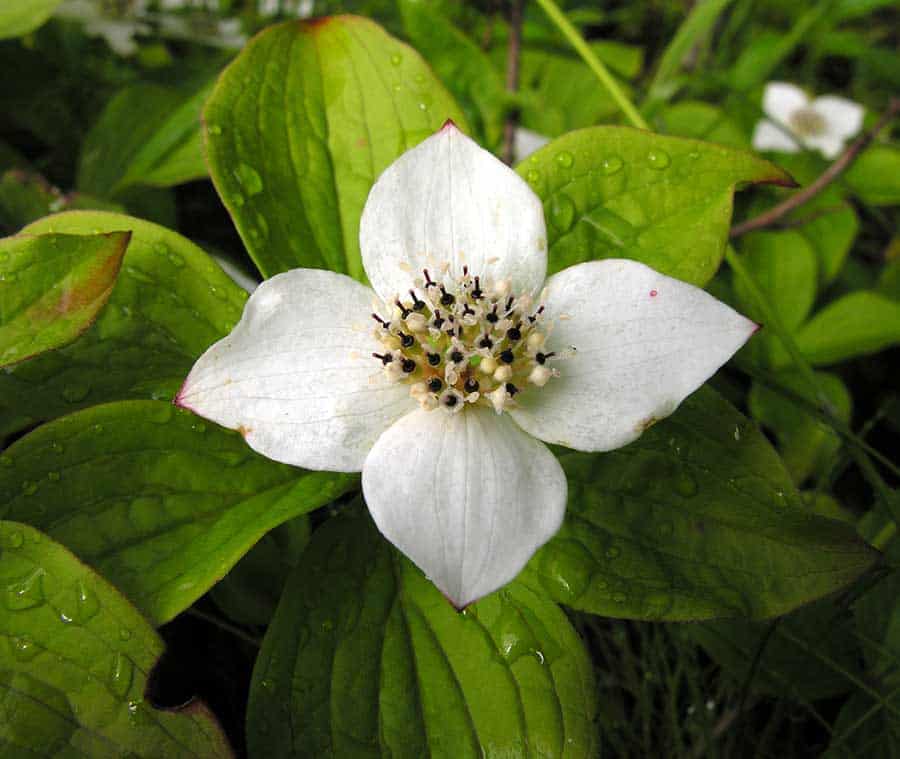

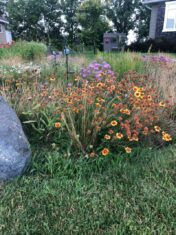

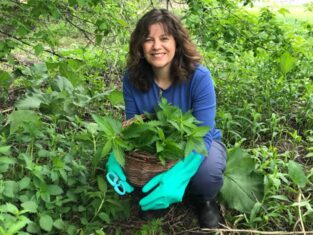

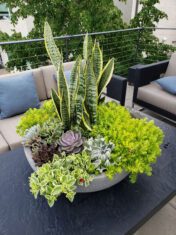


http://Www.gardensplus.ca sells Bunchberries and ships if anyone would like to give it a try. Here is link: http://www.gardensplus.ca/product/bunchberry/
Our Master Gardener group originated the National Flower vote, so I felt we should respond to this article. We think it was very important for the selected plant to grow in every province and territory. The point of the vote was to inform Canadians about some of our native flora, and to encourage them to get outside and explore this beautiful country. And to bring us together and celebrate Canada’s birthday. So knowing it grows in your province or territory brings us together, even if you can’t see it on your doorstep or buy it in the nursery.
All three of the finalists are not really commercially available. Our current symbol, the “maple” leaf, does not grow north of the tree line, and gardeners in the Yukon cannot buy them in the nursery.
But coming across bunchberry on a walk in the forest in British Columbia or in Newfoundland may possibly make us feel more connected to each other as Canadians. And that is the point of a National Symbol.
Thank you for your comments Maureen.
We live in Ontario – would prefer to walk in a forest here and see a wildflower that can be seen and enjoyed as a national plant throughout the country. We are retired and can’t afford to fly to either coast to see this plant and we are not the only people who can’t afford such an expensive trip.
A national plant should be available to be seen nationally across the country and not just in a picture.
Bunch Berry is one of my very favorite flowers and one year, for some unknown reason, one actually appeared in our garden under our cedar hedge. It was a fluke and it never came back.
A flower that represents Canada should be accessible to see and grow throughout Canada so that the patriots among us can grow it in our gardens and for general admiration in our parks. What good is a national flower if we can’t all enjoy it?
Thank you for your comments Monika. Like you, I love Cornus canadensis–where it will grow!
Canada’s Floral Emblem:
Perhaps asclepias Incarnata (native to N.A.)
The other two common ones we see often are not as wide spread across Canada… Syriaca (Southern Canada) and Tuberosa (Eastern Canada).
As our emblem, we will be reminded of the disappearing monarch butterfly.
Yes Gail, the monarchs need all the help they can get. Of course the monarch caterpillars eat the milkweed foliage, but that’s the whole point, isn’t it?
I think Bunchberry would be a perfect national flower for Canada-its flower so white and its berry red, the colours of our flag. Please could you provide photos of this plant with flower and berry to show its simple beauty. I see it in Algonquin Park.
Another good nomination would be Prairie Smoke, another relatively little known native plant- I see it in Carden Alvar in late June, its seed heads floating like a cloud of smoke over the fields.
Just adding, I see the photo of the Bunchberry flower, but a berry photo would be great, the red colour is so clear and simple against the green leaves. Anna
I had Bunchberry in my garden a long time ago for many yrs. Then one year it just wasn’t there. Don’t know why, may it got crowded out by something else? May it was a year of no snow cover or late frost. It was a pretty little plant. Never tried to replace.
I would nominate the blood root as the Canadian flower. It is beautiful, grows in northern climes and while ephemeral, brings such happiness when you find one and you can find them in garden centre.
What a great suggestion Linda! I hadn’t thought of bloodroot (Sanguinaria canadensis), but Ontario’s floral emblem (great white trillium) is also a spring ephemeral. (As is twinflower, another of the proposed national emblems in the poll).
I love the bunch berry. For those that haven’t seen it in the wild it’s time to get out of your urban backyards & see more of Canada. It’s a beautiful little plant that I won’t be trying to grow on the limestone based soil in my backyard……..
Not sure why you feel a National Flower needs to be grown in everyone’s garden. There aren’t too many plants where that would be possible; too many variables across this vast country. Bunchberry is a great choice. As already mentioned, red, white and green, and cute too! I would think the point of having a National Flower would be that is grows in every province.